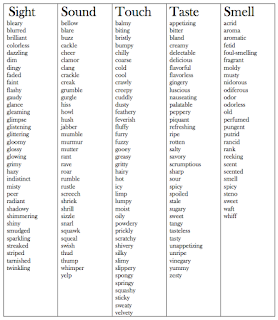Bless: While reading Tompkins chapter on teaching descriptive writing, Denise wrote that “the most beneficial element to me was incorporating sensory images. These senses can really allow the reader to feel like they are a part of your story.” Tompkins said that young writers often incorporate just one sense, sight. (p. 139). I like Denise’s idea to require students to incorporate at least three senses in their descriptive writing pieces. Tompkins shares a variety of ways that teachers can help young writers craft sensory images (p. 139). In a library setting, I could choose mentor texts that evoke the five senses and use them for read-alouds. Then, I could ask my students to help me pick some of our favorite descriptions from the book and create a list of “sensory words,” that we liked. We could keep these words up on a board for various writing activities, or we could write stories together or individually that use some of these words!
 |
| Example of a sensory words chart Source: Rocky Fork Middle School |
Address: I’d like to commend Denise for sharing her personal struggles with descriptive writing in elementary school. Denise believes writing in general was a challenge because she didn’t know what to write about. I believe this is a common struggle for young writers, and one that Tompkins addresses several times in the text. Before expecting a student to write a story (let alone make it more descriptive) students need to understand the elements of story structure which include plot, setting, characters, theme, point of view, and narrative devices. Of course, Tompkins tells us that that descriptive writing is not limited to narrative writing (p. 153), but I think it’s a good place to start before a student can write descriptively.
One way to test a student’s knowledge of story structure is to ask them to retell a story they are familiar with (Tompkins, p. 182). I think this is a great way to get young writers started, first with simple narratives and then with descriptive writing. I think it’s not realistic to ask young writers to write a descriptive piece if they haven’t mastered the basic elements of story structure. If I was working with young writers on descriptive writing and some of them didn’t know where to start, I would differentiate my instructions for those learners. Can they retell a familiar story through writing? Once the students have proven they can write a simple story, then I think it’s appropriate to press them to revise it (as Tompkins says) “using words to paint a memorable picture and evoke a distinctive mood” (p. 136).
 |
| A sample organizer that kids can use to retell a story. Source: education.com |
Press: I was glad to see that Denise included two mentor texts in her blog: Skippyjon Jones by Judy Schachner (2001) and The Stranger by Chris Van Allsburg (1986). She writes that The Stranger “would be a great resource for teaching students about how to use and implement figurative language within their writing.” I would like to know more about Denise’s specific ideas to use these two mentor texts to teach descriptive writing. After sharing Skippyjon Jones (which Tompkins says is a great example of word choice on pg. 137) how would she teach her students to write more descriptively using this book as a model?
Kudos to Denise for digging deeper into Tompkins’ chapter on descriptive writing, and I enjoyed the opportunity to add my own insight and feedback!
Source outside class textbook
Holmes, D. (2019, March 30). Entry #9. The Power of Descriptive Writing. Retrieved from https://holmessp19writing.blogspot.com/2019/03/
I wonder how you might "press" even further in this entry Michelle? How would you answer your own question given what you have learned about how best to teach students about descriptive writing?
ReplyDelete